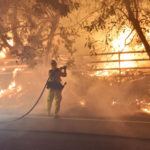The first public model to project hurricane losses for the State of Florida has been completed by the International Hurricane Research Center in Miami, Fla. The new model already has produced excellent figures on Hurricane Wilma’s insurance losses for South Florida.
The model will be unveiled May 9, at 2 p.m. at FIU’s MARC Building Pavilion, 11200 SW 8th Street in West Miami Dade. It was developed by a team of meteorologists, wind engineers, computer scientists, statisticians, financial analysts, and actuary scientists.
Florida International University professors led the team that included experts from the University of Florida, Florida State University, Florida Institute of Technology, Hurricane Research Division of NOAA, and University of Miami. Many leading experts in their fields were involved in development of this computer model.
Catastrophe models provide estimates of future insured losses that can be used by insurance companies as input in determining homeowner’s windstorm rates. The estimates are also used by regulators to help evaluate requests for rate changes. Insurance rates in Florida have been rapidly rising in recent years because of eight hurricanes striking the State in a 14-month period of 2004 and 2005.
The principal objective of the computer model is to estimate annual expected insured losses as a result of hurricanes, but it can also provide immediate estimates of losses from specific hurricane events like Katrina, Wilma, and Charley.
The model was completed at a relatively low cost ($2.7 million) over four years as funded by the State of Florida. Insurance Commissioner Kevin McCarty noted that the private, proprietary models used by the insurance industry do not allow one to see the underlying assumptions, making it difficult to evaluate requested rate increases by various companies in the different geographic regions of Florida.
This project was initiated by U.S. Senator Bill Nelson when he was Insurance Commissioner; Honorable Tom Gallagher was responsible for actually securing the funding with the help of State Senator Rudy Garcia who recognized the need and importance of a “transparent” model to Florida homeowners.
“University researchers and associates have produced a transparent model independent of the insurance industry and State regulatory agencies,” stated Shahid Hamid, Professor of Finance at FIU and Director of the IHRC Laboratory for Financial, Insurance and Economic Research who was the principal investigator of this major project.
This public model can also be used in the future to quantify the economic benefits of hurricane mitigation, which is a major contribution as hurricane damage must be lowered in order to sustain Florida’s economy. Robert Epling, President of Community Bank of Florida and Chair of the IHRC Board of Trustees stated that “The IHRC model will aid in the objective evaluation and mitigation against our ever-present hurricane exposure,” which is one of the principal reasons that the We Will Rebuild Foundation started the Center at Florida International University in the wake of Hurricane Andrew.
The Office of Insurance Regulation and FIU have asked the Florida Legislature for $1.1 million in funding to expand the applicability of the Model to include commercial structures such as condominiums and apartment buildings.
The Model is currently restricted to the analysis of single-family homes, including manufactured houses; however, a large portion of the existing Florida building stock is commercial residential buildings.
Source: Florida International University
Topics Florida Catastrophe Trends Natural Disasters Profit Loss Hurricane Education Universities
Was this article valuable?
Here are more articles you may enjoy.


 ‘Surface Waters’ on Roof Are Not ‘Flood’ Waters, Massachusetts High Court Rules
‘Surface Waters’ on Roof Are Not ‘Flood’ Waters, Massachusetts High Court Rules  USAA Renter’s Insurance Policyholder Charged with Multiple Counts of Fraud
USAA Renter’s Insurance Policyholder Charged with Multiple Counts of Fraud  How California’s Homeowners Insurance Crisis Is Affecting Brokers
How California’s Homeowners Insurance Crisis Is Affecting Brokers  Soccer Officials Arrested After Melee That Damaged Hard Rock Stadium in Miami
Soccer Officials Arrested After Melee That Damaged Hard Rock Stadium in Miami 

